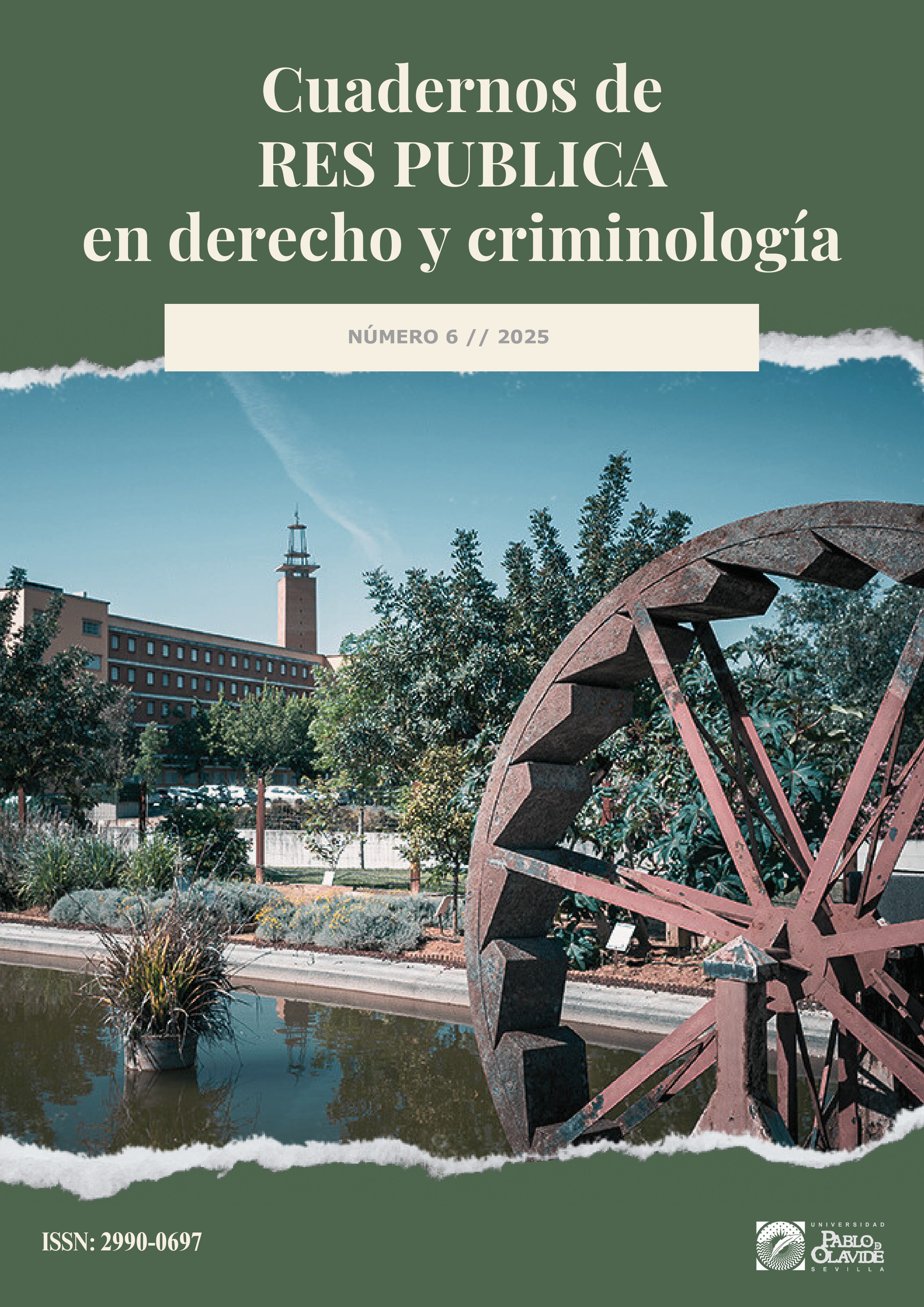Adattamento, stili di vita e pratica del tatuaggio in una prigione Messicana
DOI:
https://doi.org/10.46661/respublica.12080Parole chiave:
Colonia penale, Stili di vita in carcere, Pratica del tatuaggioAbstract
Questo articolo riconosce e spiega le caratteristiche peculiari del modo di vivere nella colonia penale di Islas Marías, in Messico, che finora non erano state realizzate; proponendo un meccanismo generativo, validato attraverso un altro fenomeno correlato, la pratica del tatuaggio in questa colonia penale. Il meccanismo richiedeva di riconoscere i principali bisogni dei detenuti (sicurezza e reperimento di risorse) e di osservare il tipo di relazioni (rilassate o tese) tra i detenuti e tra questi e il personale, sulla base di strategie di adattamento a uno spazio regolato dalle norme istituzionali e dalla subcultura carceraria. Le strategie di adattamento con cui è stato costruito il meccanismo sono quelle proposte da Goffman (Conversione, Linea intransigente, Colonizzazione e Regressione situazionale) e dagli autori (Massimizzazione dei rendimenti, Saper passare il tempo, Dare e ricevere). Sapere come buttare il tempo e Colonizzazione sono coincidenti e i più comuni.
Downloads
Riferimenti bibliografici
ÁLVAREZ LICONA, Nelson Eduardo, & SEVILLA GONZÁLEZ, María de la luz. (2021). Prison Subculture, Habitus and Adaptation; Tattooing in the Islas Marías, a Mexican Penal Colony. Advances in Anthropology. 11. 76-98. https://doi.org/10.4236/aa.2021.111007
ÁLVAREZ LICONA, Nelson Eduardo, & SEVILLA GONZÁLEZ, María de la luz. (2002). Semiótica de una práctica cultural: el tatuaje. Cuicuilco, vol. 9, núm. 25, mayo-agosto, 2002, Escuela Nacional de Antropología e Historia. Distrito Federal, México.
ÁLVAREZ LICONA, Nelson Eduardo. (1998) Las Islas Marías y la subcultura carcelaria, Boletín Mexicano de Derecho Comparado, núm. 91, enero-abril, México, UNAM, Instituto de Investigaciones Jurídicas. https://doi.org/10.22201/iij.24484873e.1998.91.3523
ÁLVAREZ LICONA, Nelson Eduardo. (2021). Theory for the Study of Identity. Advances in Anthropology. 11. 13-24. https://doi.org/10.4236/aa.2021.111002
ÁLVAREZ LICONA, Nelson Eduardo, DE LA LUZ SEVILLA GONZÁLEZ, María, y ÁLVAREZ SEVILLA, Ricardo. 2025. Conducta y adaptación en una institución total: muros de agua. La vida en una cárcel Mexicana sin rejas. Cuadernos de RES PUBLICA en derecho y criminología, febrero, 1-20. https://doi.org/10.46661/respublica.11429.
AXELROD, Robert. (1986), La evolución de la cooperación. El dilema del prisionero y la teoría de juegos. Alianza Universidad.
DI CASTRO, Elisabett. (2002). La razón desencantada. Un acercamiento a la teoría de la elección racional. México: UNAM, Instituto de Investigaciones Filosóficas
FONT RIERA, Gabriel. (1972). Tatuaje y Delincuencia. Barcelona: Resumen de tesis presentada para aspirar al grado de Doctor en Medicina.
FOUCAULT, Michel, (1995). Vigilar y Castigar, nacimiento de la prisión. Siglo Veintiuno Editores.
GARCÍA GARCÍA, José, Luis, (1992). El uso del espacio: conductas y discursos, en J. A. Glez Alcantud y M. Glez de Molina (eds), La Tierra: mitos, ritos y realidades. Anthropos.
GENOVÉS TARAZAGA, Santiago. (1991). Expedición a la violencia. Fondo de Cultura Económica.
GENOVÉS TARAZAGA, Santiago. (1995). Ciencia y Trascendencia; México: UNAM, Instituto de Investigaciones Antropológicas.
GOFFMAN, Erving, (1992). Internados. Amorrortu editores.
GRANADOS ALOS, Lucía., SURIÁ MARTÍNEZ, Raquel., PEREA RODRÍGUEZ, Carles., PAYÁ SANTOS, Claudio. Augusto, SÁNCHEZ PUJALTE, Laura., & APARISI SIERRA, David. (2023). Efectiveness of a program for the development of socio- emotional competences in people admitted to a penitentiary center. Frontiers. Public Health, (10) 1116802. https://doi.org/10.3389/fpubh.2022.1116802
HAMES, Raymond., (2017). Game Conservation or Efficient Hunting?, In book: Evolutionary Perspectives on Environmental Problems (pp.54-66); https://doi.org/10.4324/9780203792650-4
HARREL, Bill Jack. (1997). The Question of the Commons. The Culture and Ecology of Communal Reources. In; Bonnie J. McCay and James M. Acheson, Eds. University of Arizona Press, Tucson. Arizona Studies in Human Ecology. Science. https://doi.org/10.1126/science.240.4855.1082
MC. CAY Bonnie & ACHESON James, M. (1997)The Question of the Commons: The Culture and Ecology of Communal Resources, Tucson, The University of Arizona Press, pp. 92-107. https://doi.org/10.1126/science.240.4855.1082
MARTÍNEZ ORTEGA, Judith, (1959). La Isla (y Tres Cuentos). 2a. ed. UNAM. Universidad Nacional Autónoma de México.
MARTÍNEZ VEIGA, Ubaldo, (1985). Cultura y adaptación. Anthropos.
MARX, Karl, (1981). El Capital, crítica de la economía política; Cap. XXXIX: "Primera Forma de la Renta Diferencial". Siglo veintiuno editores, (primera edición 1867).
MATURANA ROMESIN, Humberto. (1995). “Todo lo dice un observador”; en GAIA. Barcelona: Editorial Kairós.
REVUELTAS, José, (2013). Los Muros de agua. Ed. Biblioteca Era. (primera edición 1941).
SÁNCHEZ FERNÁNDEZ, Juan, Oliver. (1992). Ecología y estrategias sociales de los pescadores de Cudillero. Siglo XXI.
SHALINS, Marshall., (1987)La economía de la edad de piedra. Ed. Akal.
##submission.downloads##
Pubblicato
Come citare
Fascicolo
Sezione
Licenza
Copyright (c) 2025 Nelson Eduardo Alvarez Licona, María de la Luz Sevilla González, Ricardo Álvarez Sevilla

Questo lavoro è fornito con la licenza Creative Commons Attribuzione - Non commerciale 4.0 Internazionale.




